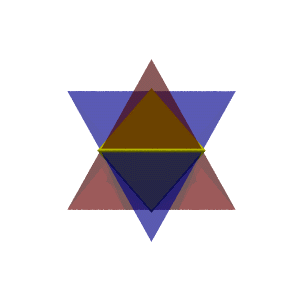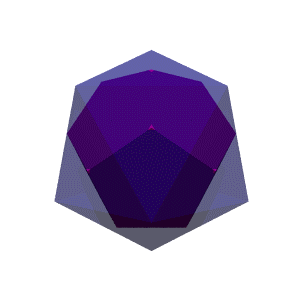- Lesson One: The Number One
- ... in Geometry
- ... in Nature
- ... in Culture
- "Uroboros" (related artwork by the author)
- "Creation" (related artwork by the author)
- Lesson Two: The Square Root of Two
- ... in Geometry
- ... in Nature, Part 1
- ... in Nature, Part 2
- ... in Culture, Part 1
- ... in Culture, Part 2
- "Duality" (related artwork by the author)
- Lesson Three: The Square Root of Three
- ... in Geometry
- ... in Nature
- ... in Culture
- "Vesica" (related artwork by the author)
- Lesson Four: Phi, or the Golden Proportion
- ... Intro, Part 2
- ... Intro, Part 3
- ... in Geometry
- ... in Nature
- ... in Nature, Part 2
- ... in Culture
- "The Flower of Phi" (related artwork by the author)
- Lesson Five: The Five Perfect Solids
- ... Intro, Part 2
- ... The Tetrahedron
- ... The Octahedron
- ... The Cube
- ... The Icosahedron
- ... The Dodecahedron
One Example of Nesting the Platonic Solids
AUTHOR'S NOTE, 01/2022 - most of the images on this page have been lost to the sands of time. I am keeping the page up with the hope that I will be able to reproduce the images at some point in the future.
As mentioned on the previous page, it is possible to contain, or "nest," every one of the Platonics within all of the others in such a way that the verticies of the nested solid will exactly touch either the verticies of the surrounding solid, the midpoints of the surrounding solid's faces, or the midpoints of the surrounding solid's edges.
Here we shall explore just one of the many methods of performing the task of nesting the solids. We have chosen this particular method many because it seems to be one of the easier to visualize.

First, let us start with the octahedron. We can easily add a tetrahedron to any face of the octahedron simply by using any of the octadedron's faces to determine the size of the tetrahedron's faces. If we take each of the octahedron's eight faces and add a perfect tetrahedron to them we create two larger opposed tetrahedrons - in other words, a star tetrahedron. In our animation, we have delineated between the two tetrahedrons by coloring one red and one blue. The space that is created by the intersection of the two tetrahedrons defines our inner octahedron perfectly.

If we then connect the outside points of the star tetrahedron and use those lines to define six faces, we find that our star tetrahedron is encased within a perfect cube. Note that the edges of the star tetrahedrons form diagonals of each of the cube's faces, each of which is a perfect square - and thus the edge lengths of the two tetrahedrons within the cube relate to the edge of the cube by the square root of two. In other words, if a given edge of the cube measures 1, then any given edge of the tetrahedron within it measures the square root of two.

Now if we encase our cube within a dodecahedron in such a way that the verticies of the cube match up with certain verticies of the dodecahedron, we find another interesting relationship - namely that each cube edge cuts across the faces of the encasing dodecahedron in such a way that the cube's edge length relates to the dodecahedron's edge length by Phi. If you are having trouble seeing how the cube fits within the dodecahedron, imagine taking one of the pentagonal faces of the dodecahedron and drawing only one line of the five-pointed start defined by the pentagon. This one line would match up with the edge of the cube within the dodecahedron.
 Original animation created by A. O'Connor for Nature's Word using POV-Ray, WWW Gif Animator, and Adobe Photoshop 5.0.
Original animation created by A. O'Connor for Nature's Word using POV-Ray, WWW Gif Animator, and Adobe Photoshop 5.0.Finally, as pointed out on the last page, if we were to encase our dodecahedron within an icosahedron, we find that the dodecahedron's verticies touch the exact center of the icosahedron's faces.
The following two animations are not necessary to understand these ideas, and simply serve as a visual recap.
![]() This
animation is very large - almost 1 million bytes. If you are unwilling
or unable to download this animation, please download the animation below.
However, if you have the time or equipment to download this first animation
it is highly recommended that you do so, as it is somewhat easier to follow.
This
animation is very large - almost 1 million bytes. If you are unwilling
or unable to download this animation, please download the animation below.
However, if you have the time or equipment to download this first animation
it is highly recommended that you do so, as it is somewhat easier to follow.
![]() This
animation is smaller, and slightly harder to follow than the above animation,
but is recommended for those with slower connections to the internet.
This
animation is smaller, and slightly harder to follow than the above animation,
but is recommended for those with slower connections to the internet.


